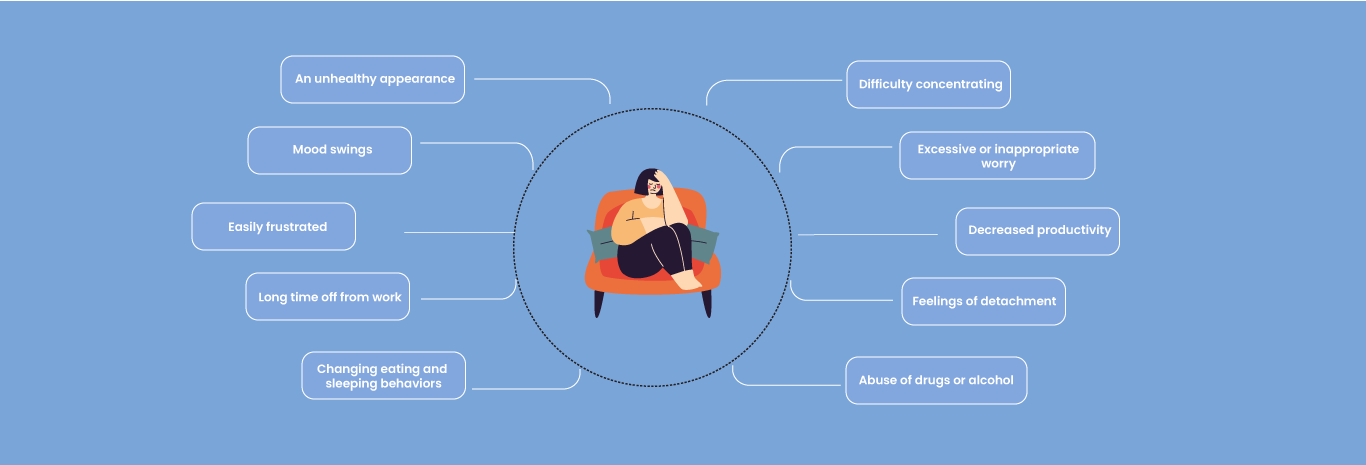Mental health has always been a critical issue in the workplace. But repeated lockdowns and confinements, restrictions, and working from home isolation due to the pandemic have further triggered this problem in organizations worldwide. And since many companies are asking their employees to return to the office, one-third of workers anticipate negative mental health impacts.
Hence, workplace mental health and well-being is no longer an option but a must-have. Mentally healthy and happy employees are more productive and motivated, whereas stressed and disillusioned staff leads to low morale and high employee turnover and recruitment costs.
This blog post will walk you through the different signs and issues related to workplace mental health, why is mental health important, and what helps to improve employee mental health and wellbeing.

What is employee mental health?
According to the World Health Organization, mental health is defined as a state of well-being in which every individual realizes his or her own potential, can cope with the normal stresses of life, can work productively and fruitfully, and is able to make a contribution to her or his community.
Employee mental health involves their social, emotional, and psychological well-being. Stress, depression, and anxiety are the most common mental issues that affect their productivity and engagement at work.
The most common workplace mental health issues:
Employee mental health issues are invisible, but they are happening all around you. Some common challenges are:
-
Inadequate health and safety policies
A workplace with poor health and safety policies can worsen employee mental health levels, make them leave the company, and decrease profitability. So, ensure the employees aren’t working in hazardous conditions, have high-quality equipment, and the workplace isn’t overcrowded and poorly lit or ventilated.
-
Performance pressure
Expecting the employees to constantly perform at their best levels can put them under excessive pressure. This can lead to increased workload and working hours, more stress, burnout, and emotional exhaustion.
-
Job security
Unemployment and job uncertainty due to COVID-19 are the biggest stressors for employees in 2022. They are afraid of not being able to pay their bills and take care of their families if they lose their jobs, which can be a threat to their mental health.
Employees don’t experience mental health challenges in isolation. Employers play a role, too — both good and bad. – Harvard Business Review
-
Less support from employers
Managers who don’t support their employees and help them cope with mental problems can make employees feel unmotivated and overwhelmed. For example, if an employee is confused about a particular project, the employer should clear their doubts instead of expecting them to figure out the tasks themselves.
-
Poor communication and management
Supportive and engaging communication and management practices can result in a strong employer-employee relationship. On the other hand, poor communication can negatively impact their relationship, increase workplace stress, and poor mental health among employees.
Signs of mental health issues in the workplace:

Understanding the signs of mental health issues is crucial for creating a healthy workplace where workers and your business can thrive together.
- An unhealthy appearance: People with mental disorders find it difficult to keep up their appearance or dress inappropriately at work. They don’t even take care of their personal hygiene habits, such as grooming, shaving, etc.
- Mood swings: Sudden changes in mood such as extreme anger or sadness can be signs of poor mental health. They can become quiet at one moment and angry at another. Or they might become confused at times and have a hard time making decisions.
- Easily frustrated: Even a down-to-earth, rational employee can become easily irritated or frustrated at work due to a mental illness. You can notice this in how they work on projects or interact with their co-workers.
- Long time off from work: When an employee starts arriving late or takes frequent leaves, they could be experiencing mental health problems.
- Changing eating and sleeping behaviors: Things like skipping lunch, refusing to eat with colleagues, and insomnia are all signs of diagnosed or undiagnosed mental illness.
- Difficulty concentrating: When a highly focused employee is suddenly unable to focus on and solve problems or is easily getting confused, he might be mentally unhealthy.
- Excessive or inappropriate worry: Feeling worried during the pandemic is normal. But, if an employee is paranoid about co-workers, stressed about their job, and has other unnecessary fears, it is a sign of mental disorder.
- Decreased productivity: Whether it’s due to lack of sleep, fatigue, or stress, mental health problems make it difficult to be productive at work. So, if an employee’s productivity is reducing day by day, he might be suffering from a mental illness.
- Feelings of detachment: Mentally ill employees might lose interest in interacting with co-workers or attending social events at the company.
- Abuse of drugs or alcohol: Employees with mental issues may turn to drugs, alcohol, or other addictions as a way to self-medicate.
Are employers responsible for employee mental health?
Many employers feel that employees’ mental health isn’t their issue. But due to the impacts of the pandemic on mental health, it’s more important than ever for employers to develop mental well-being programs for increased productivity and safety in the workplace.
Helping employees cope with stress and build up resilience is crucial for them to be happy at work and also become productive contributors to your team. High productivity can lead to reduced absenteeism and mental health conditions, ultimately resulting in reduced health care costs for the business.
Some of the positive employee mental health initiatives employers can take include:
- Offering flexible working hours
- Sharing resources and self-help tools with employees suffering from mental disorders
- Providing workplace mental health training for managers can help them identify and handle mentally unhealthy workers successfully
- Offering dedicated quiet spaces for relaxation activities to unwind and de-stress
- Free or subsidized clinical screenings from mental health professionals and mental well-being coaches
- Health insurance coverage with mental health benefits
Conducting quarterly engagement surveys to understand the existing state of mind of the employees
Explore Leena AI's Employee Engagement Surveys
Get In TouchWhy is employee mental health important?

Having good employee mental health benefits both your workplace and your bottom line. Below are a few reasons you should support mental health at workplace:
-
Increased productivity
Mental health issues at the workplace increase the amount of substance abuse, work errors, and poor decisions, resulting in lower work output. When organizations promote mental health in the workplace, it makes employees resilient to stress. Further, it can improve their thinking and decision-making ability and foster longer relationships at work. But above all, it boosts their productivity and leads to increased performance.
-
Better retention
Poor mental health is one of the primary reasons employees leave the organization. When employees struggle to find a healthy work-life balance in the workplace, they are more likely to resign. On the other hand, when they feel that employers are focusing on their well-being, their intent to stay at their company increases.
-
Reduced cost
Companies can save a lot of money in the short term by not offering mental health benefits to their employees. However, the long-term costs will be far more expensive. For example, when an employee is diagnosed with a mental health condition and takes psychiatric drugs, it can decrease their productivity and increase physical health care costs.
Therefore, promoting mental health among employees can provide financial benefits to businesses. A mentally healthy and engaged workforce is more productive with high retention rates. It will also contribute to lower health insurance payments and occupational health payments.
-
Early prevention & treatment
Educating employees on coping with mental health problems like stress and depression can help address these issues before they become severe and costly for the business. Further, HR professionals can provide a variety of options to employees to get treatment, such as wellness programs, therapy sessions, benefits plans, and more, that will improve their functioning at work.
What helps to improve employee mental health and wellbeing?

There are numerous practical things HR managers can do to promote employee mental health and wellbeing in the workplace, such as:
1. Create a healthy workplace
A healthy workplace is the #1 concern for HR managers and recruiters. It can be described as one where employees and workers actively engage in promoting and protecting all workers’ mental health, safety, and well-being. This can be achieved by reducing the work-related risk factors, developing the employees’ strengths, and addressing the mental health problems irrespective of the cause.
Here are some impactful measures organizations can take to create a healthy work environment:
- Review your workplace environment for risks that may impact the employees’ well-being. Further, get aware of the needs of individual employees and understand what changes and health policies can be adapted to promote better mental health for each worker.
- Inform your employees that support is available in the form of different wellness programs, such as employee assistance programs, mental health insurance coverage, workshops, training, and more.
- Involve your employees in the decision-making process, providing them a feeling of control and participation.
- Encourage organizational practices that support a healthy work-life balance, such as offering a flexible work environment or leisure activities in the office.
- Acknowledge the success and achievements of employees during special events, standup meetings, or casually in the office.
- Raise awareness and knowledge in your team on what promotes mental health and well-being and provide necessary, easily accessible information to everyone. You can also hold seminars or talks about mental health during these times.
- Talk to counselors and health professionals on what courses and practices you can implement to help employees manage stress and provide mindfulness training.
- Learn from the companies and organizational leaders who have succeeded in protecting employees’ mental health and well-being.
2. Support mentally unhealthy employees
Unemployment, job uncertainty, family issues, and health concerns are major factors that can have a detrimental impact on the employees’ mental health. This is why supporting your people and keeping them safe and happy should be in your best interest. Not doing so can impact the work quality, or they may even consider leaving your company.
Here’s how you can do it:
- Talking about mental health is considered a taboo subject for some people. As employers, encourage your workers to openly discuss issues related to workplace mental health such as stress, depression, and anxiety. Plus, make people understand that everyone struggles with mental health disorders sometimes.
- Educate your managers to spot the signs of mental health issues in employees and train them to address such problems immediately. A caring conversation with the team can encourage workers to get help.
- Encouraging supportive and anonymous communication throughout the team can help employees with mental health issues continue to or return to work.
Make everyone in your company understand that each employee with a mental disability has the right to work, should be treated equally, and not be discriminated against.
A list of employee mental health programs for a healthy work environment
Employee mental health programs have proven to be successful in improving productivity, building high employee morale, reducing absenteeism, and driving effective recruitment and retention. Below are some examples of wellbeing programs you can leverage in your organization:
- Run a mental health first aid course, a training program that teaches managers and staff how to notice and support people suffering from mental health at the workplace so that they can connect them with the right resources at the right time. It also includes case studies from well-known organizations so that you can learn from their actions.
- Free gym memberships can encourage employees to stay active and have a healthy immune system. Exercise can be an excellent tool for fighting illness, handling mood disorders, and ultimately improving mental health.

- Host workshops and seminars that address anxiety and stress management strategies like breathing exercises, meditation, mindfulness, and work-life balance. These can help your staff reduce depression and pressure at work and improve productivity and motivation.
- Offer mental health self-assessment tools to all employees to help them assess their risk factors. Employees who recognize the signs and symptoms of mental health are more likely to get the right treatment.
- Whether an employee is suffering from financial problems or job stress, offer employee assistance programs or EAPs. These allow them to access various employee benefit programs and therapy sessions for free so they can deal with the issues before they dampen their performance at work.
- Arrange therapy sessions for staff who feel they need it. You can include physical and occupational therapists, clinical psychologists, social workers, and other health professionals who can ask employees about their mental health issues and recommend screening, treatment, and activities as appropriate.
-
Ensure your health insurance coverage provides adequate support for employees’ mental health. You can cover both mental and physical-health-related treatments, such as acupuncture, massage therapy, chiropractors, and so on.
Summing up
The workplace never had the reputation of being a place where people can spend their bad days. But now, it shouldn’t be like that.
Around one-third of your life is spent at work, and therefore, creating a healthy workplace should be your top priority to improve your employees’ mental health. Not only does it improve productivity and reduce costs related to absenteeism, but it also makes your employee feel cared for and valued at work.
Not sure where to begin? Explore Leena.ai’s COVID-19 workplace response suite here. From going back to the office to implementing processes that keep your employees productive and cared for, the suite has everything you need.







5 Comments